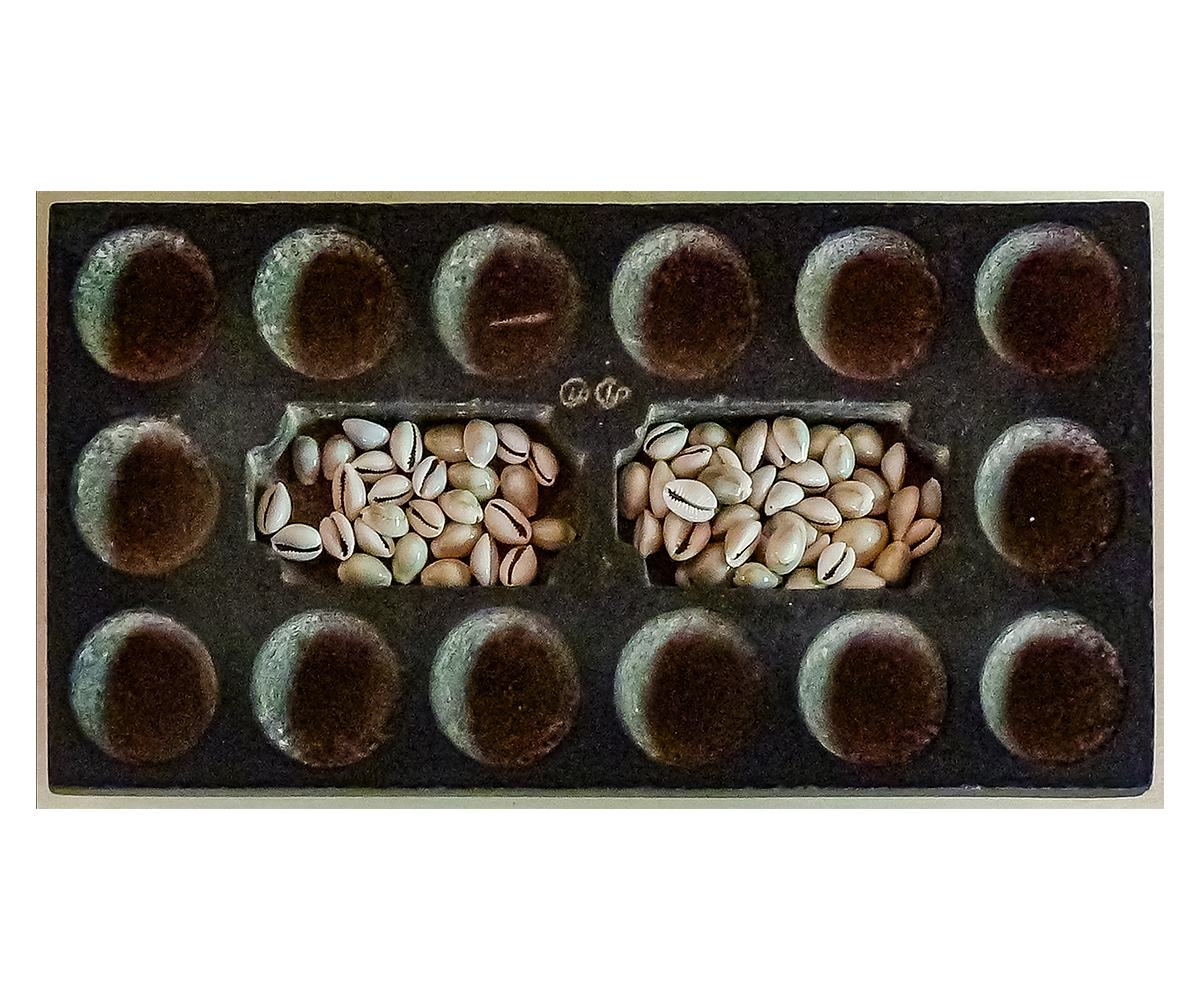ARTICLE
Pallanguzhi
A type of mancala game that originated in South India, pallanguzhi is a two-player board game traditionally popular among women of the region. Deriving its name from the Tamil and Malayalam for ‘many pits’, it is also known as aliguli mane in Kannada and vamana guntalu in Telugu. Pallanguzhi is a game of skill, requiring strategic, numerical and spatial thinking. As with many other mancala games in Africa and Asia, it is played using small objects such as pebbles or shells — generally called ‘seeds’ — on a surface with pits or depressions, with the objective being to collect the highest number of seeds through strategic moves. Its similarity to other mancala games, especially the structure of the board and the preference for using cowrie shells as seeds, suggests that it may be descended from East African games that reached India through the pre-colonial Indian Ocean trade linking the Indian coast to Africa and Southeast Asia.
While pallanguzhi can be played by up to four players, it is typically played between two players who alternate turns. A common version of the game involves a board with two rows of seven pits each, with a player seated behind either row. Cowrie shells, tamarind seeds, stones or other pellets are usually used as seeds. At the start of the game, all the pits are filled with six seeds (in some versions, one pit in each row is left empty). A player begins their turn by picking up all the seeds from any one of the pits in the row closest to them, and dropping these one by one into each successive pit, proceeding in a counterclockwise direction around the board. After dropping the last one, they repeat the process, starting with the seeds from the following pit, continuing this way until the last seed in a handful is dropped into a pit that is followed by an empty pit. At this point, the player collects all the seeds from the next pit instead of proceeding; in many versions, they also collect the seeds from the facing pit in the opponent’s row. Then the opponent’s turn begins, and they proceed the same way, starting from any pit on their side. The players alternate turns each time one of them collects seeds. During a turn a player may also collect the seeds from a pit if they have added up to exactly four. A round of pallanguzhi ends when all the seeds have been collected.
To set up the next round, each player uses their seeds to refill the pits on their own side of the board with the original number of seeds. The player with additional seeds collected from the previous round keeps these in their collection, thus getting a head start; while the other player must block out the pits that they have been unable to fill completely. These pits are not included in the gameplay of the new round, placing the trailing player at a disadvantage in terms of choosing pits from which to pick and deposit shells. However, if the player is able to collect six shells, they may choose to deposit these in the blocked pits during the round, thus reviving the pit. The game is over when a player has collected less than the original number of seeds at the end of a round, and is therefore unable to refill any pits to begin a new round.
Several variations of pallanguzhi exist across the South Indian states. While the rules are usually the same, the number of seeds varies, ranging from four to twelve per pit, with five or six most commonly used. In order for three or four players to play, the board is divided into as many parts, with a certain number of pits assigned to each player. In local languages depending on the region, the pits are often referred to as ‘houses’, and the collection of seeds as ‘capturing’. As the counters are called seeds, the act of dropping seeds into the pits is referred to as ‘sowing’. Historically, boards have been made from wood, with precious materials like sandalwood, ivory or silver used in those commissioned by the wealthy. The boards are sometimes hinged so they can be folded and easily carried, and often feature two larger cavities, in which players deposit their respective seed collections during the game.
The game is rarely played in urban areas today, and has traditionally been more popular in rural parts of South India, especially among women. Here it is commonly played on temporary surfaces, by simply creating rudimentary pits or a grid in sand and using any available material as seeds. Women are also known to have played pallanguzhi during the night-long celebrations for festivals such as Shivaratri and Ramzan. The game is particularly noteworthy on a practical level for training players in quick arithmetic and hand-eye coordination. Organisations such as Kreeda are making an effort to revive pallanguzhi and other traditional games by packaging and selling contemporary versions, and introducing them to families, students and researchers.
Bibliography
Anantharaman, Ambujam. “Games That Sharpen Your Mind.” Spectrum, December 23, 2007. Accessed September 29, 2023. https://www.tribuneindia.com/2007/20071223/spectrum/society.htm.
Bhatt, Neha. “Pallanguzhi Days.” Outlook, August 30, 2010. Accessed September 29, 2023. https://www.outlookindia.com/magazine/story/pallanguzhi-days/266781.
Mohr, Merilyn Simonds. The New Games Treasury: More Than 500 Indoor and Outdoor Favorites with Strategies, Rules and Traditions. Boston: Houghton Mifflin Company, 1997. Accessed September 29, 2023. https://archive.org/details/newgamestreasury0000mohr/page/68/mode/2up.
Periwal, Seema, and Ravi Poovaiah. “Pallankuzi.” D’Source. Resources: Indian Games. Accessed September 29, 2023. https://www.dsource.in/resource/indian-games/board-games/pallankuzi.
Saju, MT. “Time to Revive Forgotten Board Games.” The Times of India. March 23, 2017. Accessed September 29, 2023. https://timesofindia.indiatimes.com/city/chennai/time-to-revive-forgotten-board-games/articleshow/57783626.cms.
Varma, Dinesh M. “Rustic Board Game Scores at Swiss Scholarly Meet.” The Hindu. September 20, 2006. Accessed September 29, 2023. https://web.archive.org/web/20070621035708/http://www.hindu.com/2006/09/20/stories/2006092016770200.htm/.








